Physical Address
304 North Cardinal St.
Dorchester Center, MA 02124
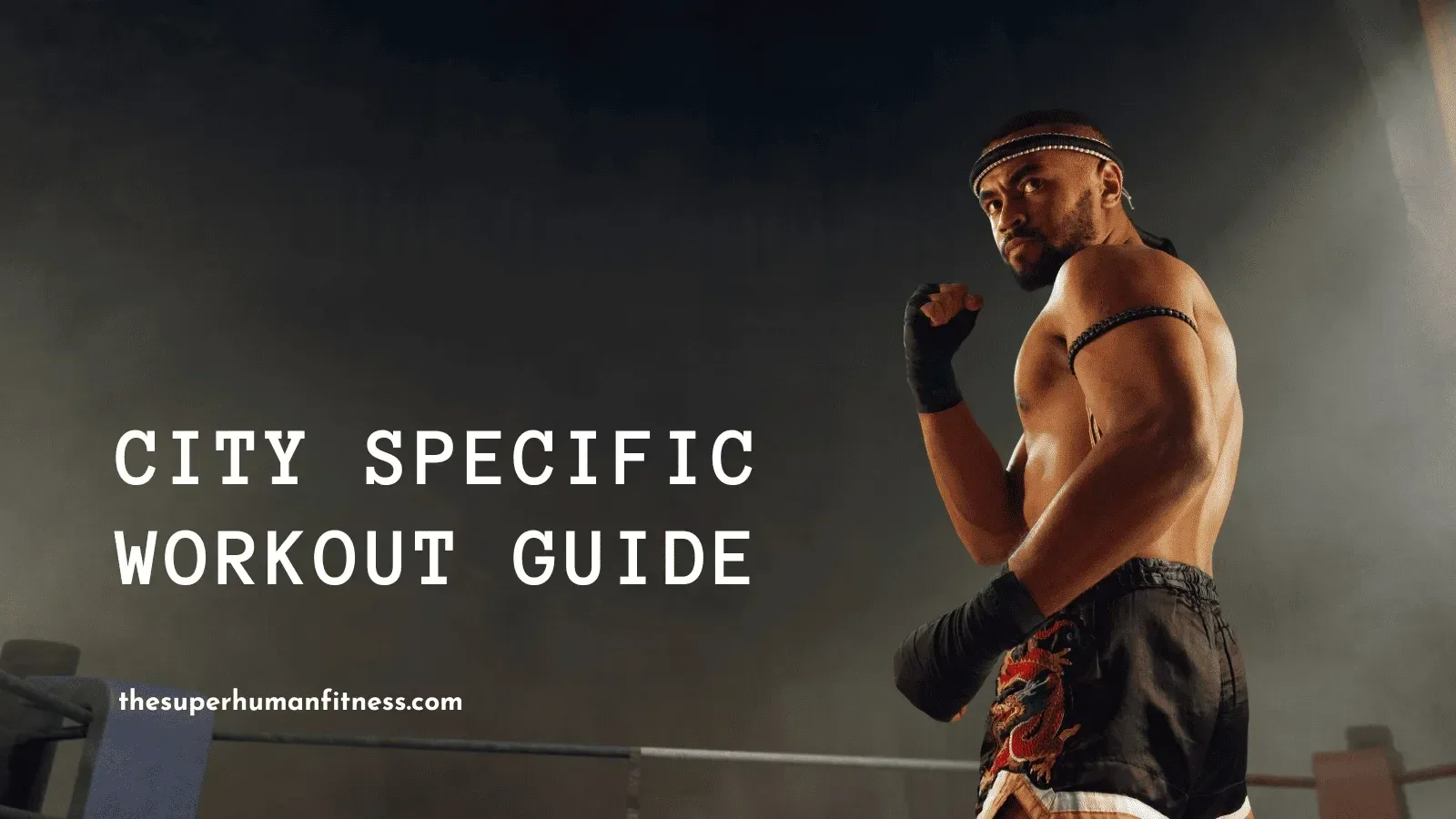
Ready to globetrot without even leaving your living room? Buckle up, folks! We’re about to embark on a thrilling fitness adventure that’ll have us jet-setting around the world, sampling workouts inspired by the cities and cultures we virtually ‘visit’.
Forget tourist traps and language barriers; the only passports we’ll need are our enthusiasm and a bit of space to break a sweat.
This journey isn’t just about the scenic route. It’s about turning every city stopover into a unique fitness challenge, all from the comfort of your own home.
Can’t fly to Russia? No problem! We’ll bring the powerful simplicity of a Russian Kettlebell workout to your living room. Always dreamed of visiting India? Get a taste of tranquility with an Indian yoga routine.
So grab your water bottle and get ready to globetrot! Whether you’re a seasoned traveler or someone who just dreams of exploring different corners of the world, here’s your chance to dive into the rich tapestry of global fitness.
On this adventure, we’ll explore, we’ll sweat, and we’ll discover new ways to stay fit. After all, who said fitness couldn’t be your passport to the world?
Table of Contents
Just picture this. The sun is breaking over the horizon, painting the sky with hues of gold and red. You’re in the heart of India, about to embark on a journey into tranquility and fitness with a simple mat beneath your feet. Intriguing, right?
Welcome to the world of Yoga—a millennia-old practice that is a perfect blend of physical postures, breathing exercises, and meditation.
Yoga, a gift to the world from India, is more than just stretching. It’s about creating balance in the body through developing both strength and flexibility. The beauty of yoga is that it caters to people of all fitness levels—from complete beginners to seasoned practitioners.
It’s a lifestyle that aims for a blissful union of mind, body, and spirit. It’s a workout for the soul, as much as it is for the body.
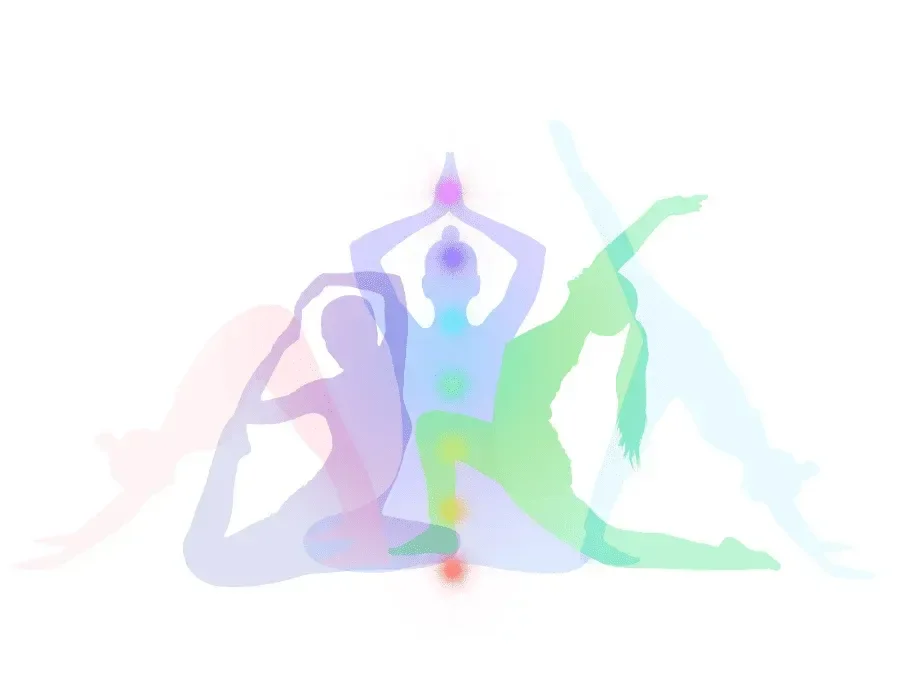
A Dance with the Sun No Yoga session is complete without the Sun Salutation, a dynamic sequence of twelve flowing postures that pay homage to the life-giving sun. This series of 12 dynamic poses is an excellent total body workout, stimulating your cardiovascular system while stretching and strengthening your muscles.
It’s not just an exercise; it’s a ritual that vitalizes the body and calms the mind.
Trees are firm, resilient yet peaceful – qualities we could all use a bit more of, right? The tree pose, or Vrikshasana, captures this spirit of quiet strength. This balancing asana challenges your stability, strengthens your legs, and instills a sense of calm.
The Downward Dog is more than a popular Yoga pose; it’s a full-body refresh. The Downward Dog is an all-encompassing pose—a full-body stretch that works on your upper body strength while calming the mind. It’s also great for runners as it helps stretch those tight hamstrings and calves.
No yoga practice is complete without focusing on your breath. Pranayama, or breath control, is a crucial part of yoga. It promotes relaxation, reduces stress, and enhances your concentration. An easy way to start is with deep, controlled breathing—inhale slowly through your nose, hold for a few seconds, then exhale gently.
So there you have it, a slice of India served through a Yoga routine that revitalizes your body and feeds your soul. But don’t roll up your mat yet; we’re just getting started! Our global fitness expedition has many more stops. From the spiritual landscapes of India, we’re jetting westward. Stay tuned for our next global fitness destination!
Alright, fitness voyagers, pack away your yoga mats because we’re swapping serene stretches for some vivacious vibes. Next stop on our global fitness expedition? The fiery heart of South America – Brazil! Get ready to immerse in the infectious rhythm of Capoeira, a martial art that dances on the line between combat and choreography.
When Dance Meets Martial Art Capoeira, born from the struggle of African slaves in Brazil, is a unique blend of dance, martial art, acrobatics, and music. Capoeira is more than a martial art; it’s a game, a dance, a form of expression. Players form a circle (the “roda”), with two players in the center engaging in a dialogue of movement. There’s no winner or loser. It’s all about the flow, grace, and rhythm.
So, slip into your abadá (Capoeira pants), and let’s dive into this rhythmic rollercoaster!
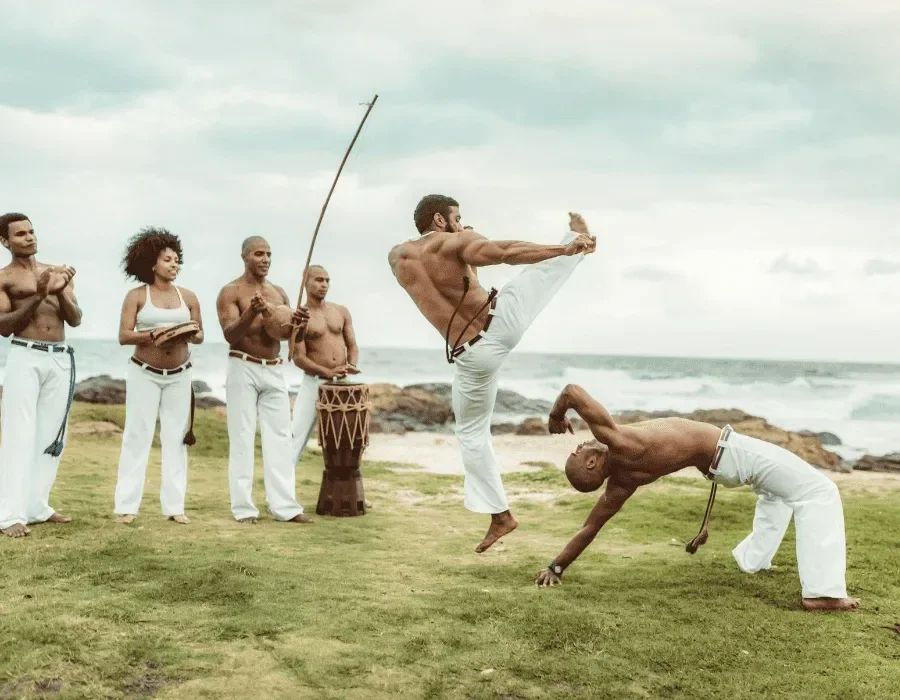
The Swinging Soul of Capoeira The Ginga, or swing, is the fundamental footwork of Capoeira. It’s a dance, a defense, a bait – it’s whatever you make of it. Everything in Capoeira starts with the Ginga. It’s a rhythmic, side-to-side movement that prepares you for kicks and dodges.
The Ginga keeps you moving, making you a difficult target for your opponent, while getting your heart rate up.
The Artful Dodger In Capoeira, you don’t just block; you evade, you dance around the attack, you respond with grace. Esquivas are these evasive maneuvers, and they’re as varied as the beats of a berimbau.
The goal isn’t to block an attack, but to gracefully avoid it—keeping the game flowing. There are various dodges, each involving fluid movements that engage your core and lower body.
The Fiery Showstoppers Capoeira is not all dance and evasion; it has its share of fiery kicks and acrobatics. Capoeira includes a myriad of kicks and acrobatics. From straightforward push kicks (martelo) to flashy cartwheel kicks (meia lua de compasso), there’s a kick for everyone.
But remember, the goal isn’t aggression—it’s a dance. The acrobatic flips and cartwheels add a further level of athleticism and flair.
Now, it’s time for you to get into the “roda”. Start with the Ginga, feel the rhythm, then mix in some kicks and dodges. Don’t forget the music—Capoeira isn’t Capoeira without the pulsating beats. The focus here isn’t on perfection; it’s about having fun and moving your body in new and exciting ways.
So there we have it, a taste of Brazil served through a lively Capoeira workout. But don’t put away your workout gear just yet! Our global fitness journey has more exciting destinations waiting. From the rhythmic circles of Brazil, we’re off to another country with rich cultural workouts. Get ready, and stay tuned!
Pack your virtual bags, fitness globetrotters, because our next destination on this exercise exploration is none other than the land of the formidable bear – Russia. Known for its disciplined strength training, Russia has a cultural affinity for one piece of equipment that packs a powerful punch – the kettlebell.
Though it’s not strictly bodyweight, this globetrotting workout tour wouldn’t be complete without a nod to this simple, yet remarkably effective, tool.
The Russian Powerhouse An unassuming cast-iron ball with a handle on top, the kettlebell has roots in Russian fitness culture dating back to the 18th century. Used initially for weighing crops, it quickly made its way into strength training routines of Russian strongmen. Today, we bring this historical piece of equipment to your travel-inspired workout, promising a full-body burn.

The kettlebell swing is a simple but challenging move that engages your entire body. By swinging the kettlebell from between your legs up to shoulder height, you engage your core, glutes, hamstrings, shoulders, and grip. The key to a good swing is to hinge at your hips, keep your spine neutral, and use your hips to power the movement.
The clean and press is a two-part movement that works your lower and upper body. You’ll start with a clean—squatting down, lifting the kettlebell to your shoulder while extending your hips, then standing upright. From there, you press the kettlebell overhead. This move requires balance, coordination, and strength, making it a kettlebell classic.
Named for the way you hold the kettlebell close to your chest, the goblet squat is a fantastic exercise for your lower body. It works your quads, glutes, and hamstrings, while also engaging your core. Remember to keep your chest up and push your knees out as you squat down.
Channeling Your Inner Russian Strongman Weaving these exercises into a complete workout, you’ll get a taste of Russian resilience and strength.
Ready to put these moves together? Start with a simple routine—10 swings, followed by 5 clean and press on each side, then finish with 10 goblet squats. Repeat for 3-5 rounds, and you’ve got yourself a full-body, Russian-style kettlebell workout.
So, there you have it. A little piece of Russia in the form of a kettlebell workout. As we wrap up this workout, keep your sweatbands handy, because we’re not done yet. The next stop on our global fitness expedition is waiting!
Lace up those sneakers, my fit wanderlusters, because we’re headed to the high-altitude terrains of Kenya – home to some of the world’s most decorated marathon runners. Famous for their extraordinary endurance, Kenyan athletes have, over the years, become synonymous with long-distance running.
In this segment of our fitness journey, we’ll delve into a running workout that captures the essence of Kenya’s endurance training philosophy.
The Kenyan approach to running is built on simplicity, consistency, and an undying resolve. The workouts are intense, yes, but they are also grounded in steady progress and a deep respect for the sport.
Kenyan runners are globally recognized for their endurance and speed. Their training philosophy centers around patience, discipline, and the concept of running “slow to run fast.” This approach is rooted in gradually building up mileage and speed over time, enhancing both stamina and efficiency.
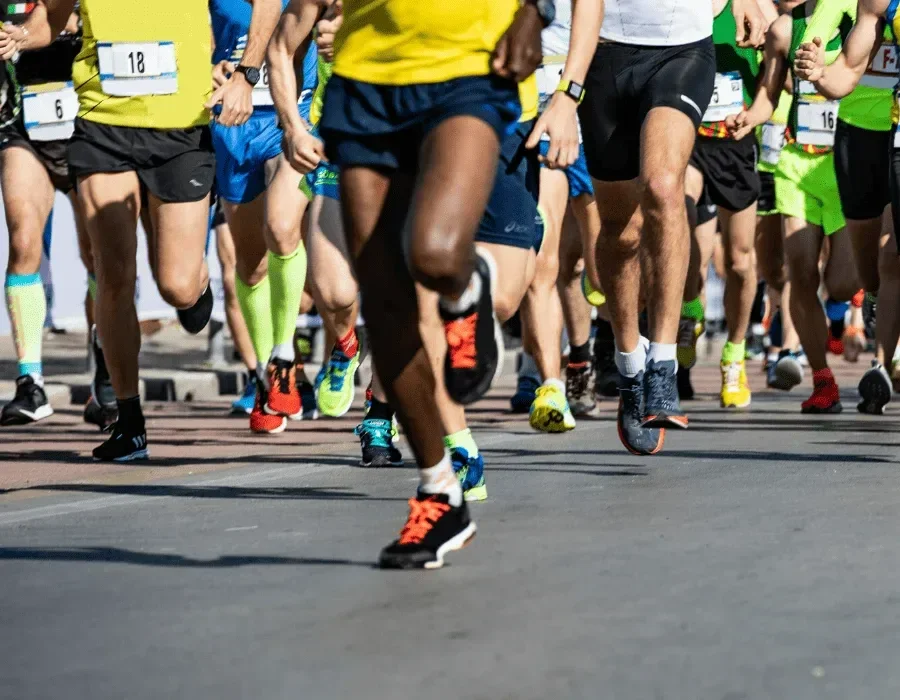
In Kenya, slow long runs are a staple for building endurance. Typically, these runs are done at a comfortable pace, allowing runners to cover more distance without overtaxing their bodies. By gradually increasing the length of these runs, you can enhance your aerobic capacity and teach your body to burn fat more efficiently.
Kenyan runners incorporate hill workouts into their training routine, strengthening their legs, increasing their stride power, and improving their running efficiency. These workouts usually involve repeated runs up a moderate to steep hill, followed by a recovery jog down.
Riding the Edge Next in line are the tempo runs. Tempo runs, also known as threshold runs, are performed at a “comfortably hard” pace for a set duration. A crucial part of Kenyan running philosophy, these runs are designed to improve your lactate threshold – in simpler terms, to help you run faster, for longer.
Begin your Kenyan-inspired running routine with a slow long run, aiming to stay out for at least 30 minutes. Gradually increase your duration over weeks. Include a hill workout once a week, starting with a few repetitions and adding more as you get stronger. Finally, incorporate a weekly tempo run, starting with 10 minutes at your “comfortably hard” pace and increasing over time.
And just like that, we’ve crossed another fitness landmark on our global workout journey. As we wind up our Kenyan expedition, we’re already prepping for our next destination. Fitness adventurers, stay tuned!
Settle into a calming state of mind, fitness explorers, as we journey into the heart of China to immerse ourselves in the world of Tai Chi. Originating from ancient Chinese philosophy, Tai Chi is a martial art known for its gentle, flowing movements that harmonize the mind, body, and spirit.
In this segment, we’re shifting gears from the high-intensity workouts and focusing on balance, tranquility, and precision.
To truly experience Tai Chi, we must first delve into its philosophy. Rooted in the principles of Yin and Yang, Tai Chi seeks to balance opposing elements and encourage a peaceful state of mind.
Tai Chi is characterized by its slow, graceful movements, each flowing into the next without interruption, hence often referred to as “meditation in motion”. It’s rooted in the Chinese philosophy of Taoism, aiming to cultivate ‘Chi’ or life energy within the body.
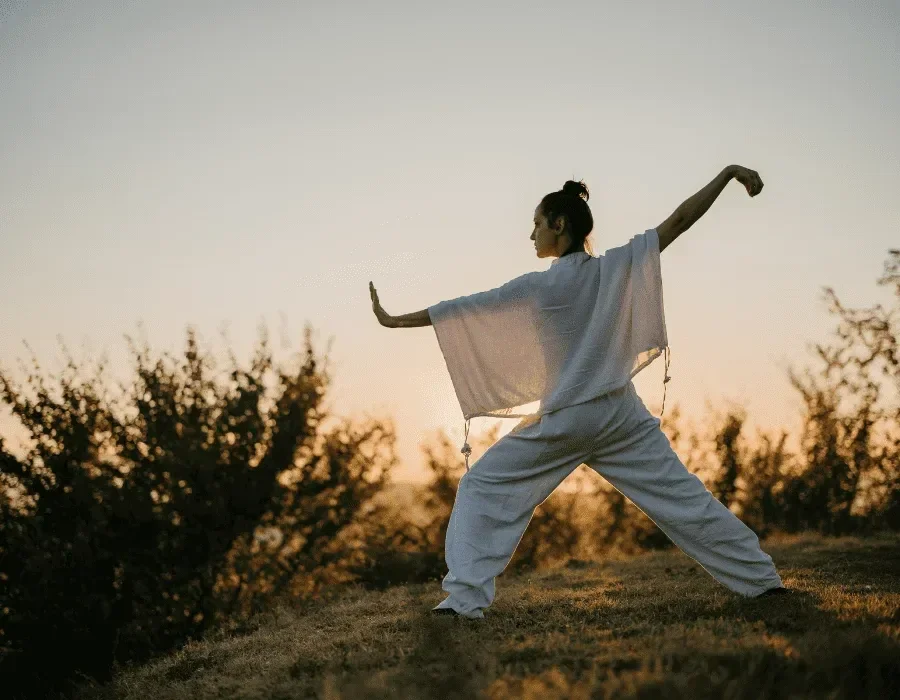
The essence of Tai Chi lies in harnessing and balancing the ‘Chi’. Practicing Tai Chi is believed to balance the yin and yang within your body, promoting overall health, tranquility, and even improving mental clarity.
The Tai Chi Forms Tai Chi isn’t just a workout; it’s a dance where each move flows into the next. Each form is designed to target specific aspects of wellness and to stimulate certain energy pathways within your body. Some popular forms include the Yang style, known for its slow, expansive movements, and the Chen style, known for its combination of slow and fast, explosive movements.
The Art of Tai Chi Breathing Breathing in Tai Chi is not just a necessity, it’s an integral part of the practice. By coordinating slow, deep breaths with the movements, practitioners can achieve a higher state of mindfulness and relaxation.
Start your Tai Chi workout with simple forms, like “Wave Hands Like Clouds” or “Grasp the Sparrow’s Tail”. Focus on moving fluidly and coordinate your breathing with each movement. As you get comfortable, you can start learning more complex forms. Practice regularly, and over time, you’ll notice improved balance, flexibility, and peace of mind.
As we wrap up our Tai Chi experience, it’s clear that fitness isn’t always about heart-thumping, sweat-dripping sessions. Sometimes, it’s about slowing down, moving with intent, and finding harmony within yourself. On to the next stop on our world fitness tour!
Vive la France! Prepare to unleash your inner thrill-seeker as we dive into the exciting world of parkour, straight from its birthplace. Fusing power, agility, and precision, parkour is not just a workout – it’s an exhilarating expression of freedom, transforming the urban landscape into your personal playground.
This dynamic training discipline uses movements that developed from military obstacle course training. It’s all about moving efficiently through your environment using only your body. So, let’s run, jump, and climb our way through a Parkour-inspired workout.
Parkour Origins Every great movement has a story, and parkour is no different. Born in the concrete jungles of France, parkour, or ‘the art of displacement,’ is all about moving from point A to B in the most efficient way possible.
It encourages functional strength, flexibility, and balance. Not just a physical challenge, it’s also a test of mental fortitude, creativity, and resilience.
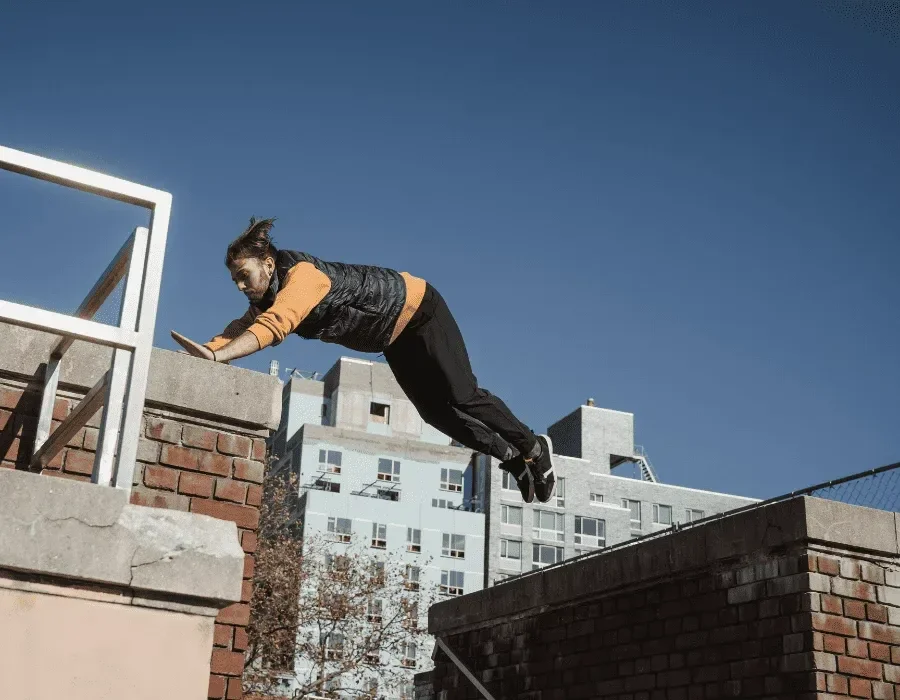
Understanding Parkour Principles Before we jump (quite literally) into the workout, it’s essential to grasp the fundamental principles of parkour – safety, efficiency, and fluidity. Brace yourself for a blend of fitness and philosophy!
Parkour is more than just running and jumping. It’s about freedom, expression, and engagement with the environment. It fosters a sense of community, encourages safety and respect, and inspires practitioners to overcome personal barriers.
Basic Parkour Moves Parkour may seem daunting, but fear not, we’re starting simple. Some fundamental movements in Parkour include the “precision jump” for leaping between spots, the “wall run” for scaling walls, the “kong vault” for clearing long obstacles, and the “roll” for minimizing impact during landing.
Your City is Your Gym With the basics under your belt, it’s time to view your surroundings in a new light. Starting Parkour can be as simple as practicing jumping, landing, and rolling safely. While the stunts seen in videos may seem intimidating, they are the result of years of progressive training. Start slow, focus on mastering basic movements, and always prioritize safety.
Unleash Your Potential Ready to hit the ground running? Kickstart your Parkour journey with a simple routine: begin with a warm-up run, practice precision jumps between lines on the floor, try a few wall runs on a safe, low wall, and finish with safety rolls on a soft surface. Always remember, the aim is not speed but control and precision.
As our parkour journey concludes, remember that the world is your oyster (or, in this case, your gym). Embrace the rush, keep safety in mind, and the cityscape will never look the same again. On to our next world-inspired workout!
Say g’day to Australia, the land of sun-soaked beaches, vibrant wildlife, and outdoor lovers. Here, fitness isn’t just a habit, it’s a lifestyle, deeply embedded in the culture. We’re about to soak up some Aussie inspiration and channel it into a heart-pumping, functional fitness workout that’s as fun as a day at Bondi Beach!
Where the Outdoors is a Gym Australia’s unique geographical diversity, coupled with the locals’ love for staying active, makes it the perfect source of inspiration for our next fitness adventure. The Australian way of training places emphasis on outdoor activities, sports, and exercises that mimic natural human movements, all of which comprise functional fitness. Let’s explore what functional fitness means in the Aussie context.

Functional fitness is all about training your body for everyday activities, making them easier and safer. Functional fitness is about preparing your body for real-life activities, not just isolated exercises. It emphasizes compound movements that involve multiple joints and muscles, replicating actions like lifting, pulling, or pushing that we encounter in everyday life.
Australians love the outdoors, and they’ve found fun ways to turn this passion into an effective workout. From beach volleyball to surfing to bushwalking, Aussies love their outdoor activities. These are not only fun ways to enjoy the beautiful landscape but also fantastic functional workouts that engage multiple muscle groups in dynamic movements.
Inspired by Australia’s active culture, we can design a functional fitness workout that incorporates movements from various outdoor activities. Think sandbag lifts for strength (inspired by beach activities), agility ladder drills for coordination (drawing from field sports), and burpees for full-body conditioning (mirroring the physical exertion of surfing).
Start with a dynamic warm-up, then move onto the sandbag lifts, followed by agility ladder drills, and wrap up with a set of burpees. Aim for two to three rounds of the circuit. Remember, the focus here is on the quality of movement, not speed.
As we wrap up our Australian leg of the fitness journey, remember that the great outdoors is waiting for you! So, pull on those trainers, head out, and live your Aussie-inspired fitness life. What’s next on our global fitness tour? Keep reading to find out!
Welcome to Nepal, a country that proudly hosts the highest peaks in the world. The home of the mighty Mount Everest, Nepal is synonymous with high altitude and an indomitable spirit of resilience. If you’re ready to train like a mountaineer, brace yourself for a workout inspired by Sherpas and high altitude training in Nepal.
High altitude training has long been a secret weapon for many professional athletes. Nepal, with its towering Himalayan ranges, is a haven for high altitude training, a type of training that pushes your endurance to the next level. It is widely embraced by mountaineers, athletes, and Sherpas, who’ve made these high-altitude terrains their home.
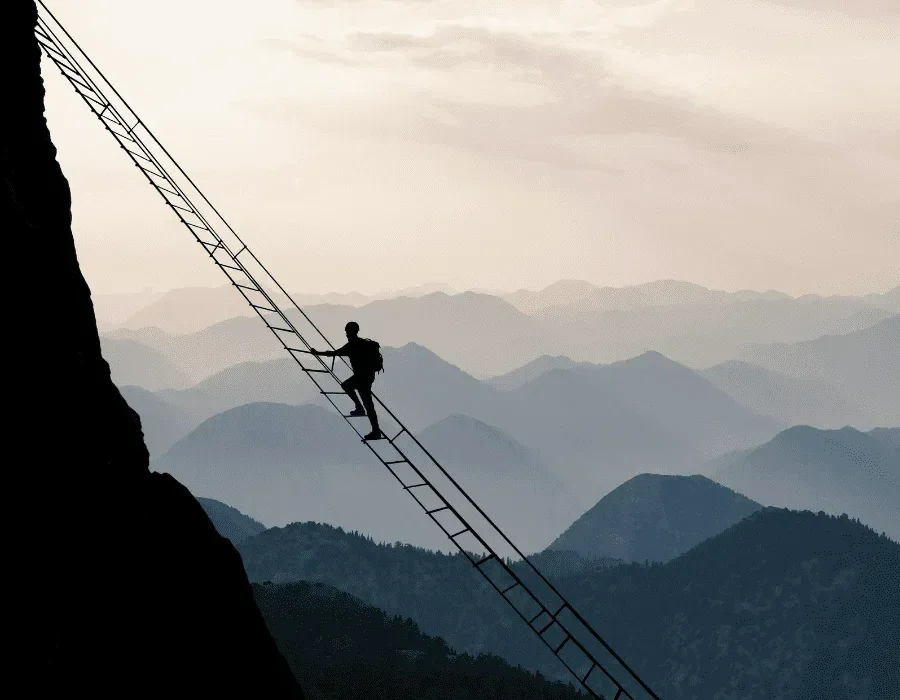
Discover how training at high altitude works wonders on our cardiovascular system, enhancing our stamina and endurance. But remember, we’re aiming to mimic, not induce, altitude sickness!
At higher altitudes, your body has to work harder due to the lower levels of oxygen in the air. This can enhance your fitness by improving your body’s ability to utilize oxygen and boost endurance.
Sherpas, indigenous people of the Himalayas, have incredible stamina and endurance, developed over generations living and working in these high-altitude conditions. They’re a testament to the transformative effects of altitude training.
Even if you don’t have a Himalayan peak in your backyard, you can simulate the effects of high altitude training. This involves exercises that enhance cardiorespiratory fitness like stair climbing, hill sprints, and high-intensity interval training (HIIT).
Begin with a stair climbing session, followed by a series of hill sprints. Wrap it up with a HIIT workout. The aim here is to push your body to its limits, replicating the challenges of high altitude training. Be sure to focus on your breathing during each exercise.
Our journey through Nepal brings a breath of fresh mountain air to our fitness adventure. As we bid goodbye to the Himalayan heights, we can’t wait to see where our fitness journey takes us next. Stay tuned for more city-specific workouts!
Welcome to Thailand, the Land of Smiles, and more importantly for us fitness enthusiasts, the birthplace of Muay Thai. This martial art is famous for its powerful strikes and athletic agility. A practice deeply embedded in Thai culture, Muay Thai is as much a workout as it is a testament to the strength of the human spirit. Ready to channel the fighter within you? Here’s a workout inspired by the mighty ‘Art of Eight Limbs’.
Muay Thai isn’t just a martial art—it’s a part of Thailand’s culture and history. Muay Thai, also known as ‘The Art of Eight Limbs’, utilizes the hands, feet, elbows, and knees to form a full-body workout. In the heart of Thailand, it is more than a sport – it’s a way of life that embodies discipline, respect, and spirituality.
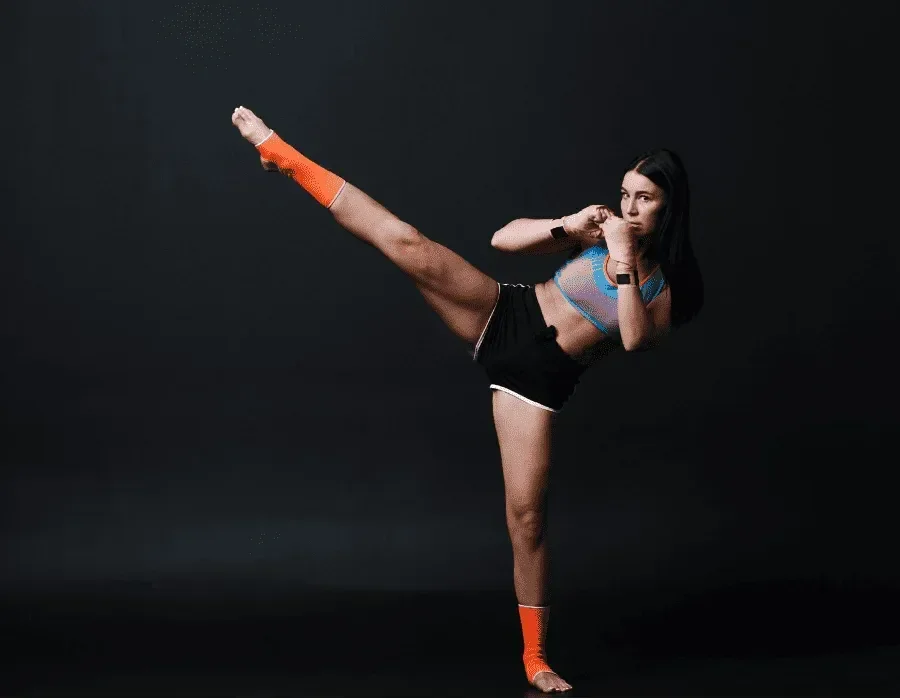
Muay Thai is known as the “Art of Eight Limbs” for a reason. This martial art makes use of punches, kicks, elbows, and knee strikes, making it a full-body workout that pushes your endurance, strength, and flexibility.
From powerful kicks and knee strikes to swift elbow and punch combinations, each Muay Thai movement requires precision, power, and grace. With the right training, these movements can greatly enhance your speed, agility, and overall fitness.
Whether you’re a martial arts enthusiast or a fitness buff looking for a dynamic workout, this Muay Thai-inspired routine is sure to get your heart pumping. It includes bodyweight exercises that mimic Muay Thai movements – think roundhouse kicks, knee strikes, elbow strikes, and more.
Start with a dynamic warm-up, then dive into the sequence of kicks, strikes, and combos. Remember, the goal isn’t just to burn calories – it’s to channel the discipline and fighting spirit inherent in Muay Thai.
As we wrap up our time in Thailand, we’re not just leaving with a great workout—we’re also carrying with us the warrior spirit of Muay Thai. Our global fitness journey continues, and we can’t wait to see where we’ll go next!
Ah, the good old USA, the birthplace of CrossFit—a high-intensity fitness regimen that has taken the world by storm. CrossFit is all about rugged resilience and pushing past your limits. Here, we’re going to dive into the essence of CrossFit and adapt it to a bodyweight workout that can be performed anywhere, even in the comfort of your hotel room.
CrossFit, founded in the USA, is about more than just getting fit—it’s about pushing your limits and developing a level of rugged resilience. CrossFit was born out of the desire to forge a broad, general, and inclusive fitness. It is a fitness regimen that has revolutionized the way we view fitness by combining strength training, aerobics, and gymnastics all in one workout.
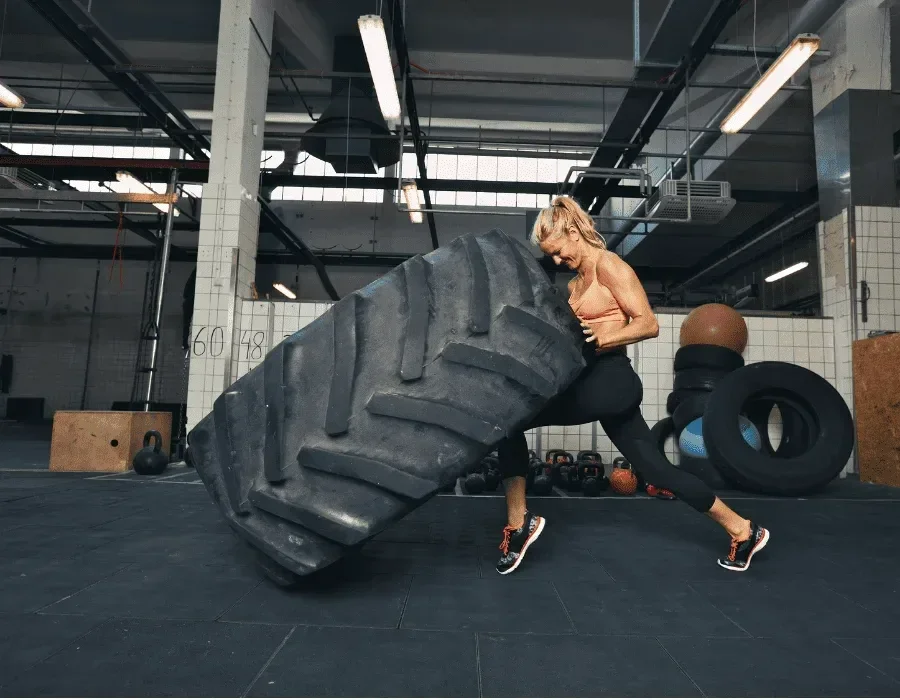
The ethos of CrossFit lies in its universality. It believes in preparing the body not just for the known, but also the unknown. The beauty of CrossFit lies in its adaptability – workouts can be scaled to suit anyone’s capabilities.
While CrossFit is often associated with equipment-laden gyms and a vast array of tools, the spirit of CrossFit is far from limited by equipment availability. At its core, CrossFit is about pushing your boundaries, improving your fitness, and optimizing your body’s potential. You can achieve this whether you have access to a fully-equipped gym or not.
The essence of CrossFit lies in functional movements that reflect aspects of gymnastics, weightlifting, running, and more. These movements are often natural and mirror those that are used in day-to-day life. As such, they can be adapted and performed without the need for specific equipment.
For instance, if you don’t have a barbell, you can substitute it with bodyweight exercises that target similar muscle groups. Squats can be done in place of barbell squats, push-ups can replace bench presses, and burpees can serve as an excellent full-body exercise in the absence of equipment.
Moreover, many elements of CrossFit, such as developing cardiovascular endurance, improving flexibility, and enhancing agility, can be worked on without any equipment. All you need is a little creativity, and you can turn any space into your training ground.
This CrossFit-inspired routine will challenge your strength, endurance, and agility. Each exercise is designed to push your limits and make you stronger, faster, and more powerful. Remember to maintain good form and push yourself to your maximum capacity.
Remember, the key to any successful workout is to listen to your body. Don’t rush through the exercises. Instead, focus on maintaining good form and steady breath. It’s not about how fast you can complete the workout, but how well you perform each movement. Happy training!
As we close the chapter on our American fitness adventure, we’re leaving with a new appreciation for the power of high-intensity workouts and the rugged resilience that defines the spirit of CrossFit. Where to next on our worldwide fitness journey? Stick around to find out!
As we bring our global fitness journey to a close, it’s clear that the world is your gym. From the tranquil yoga asanas in India to the dynamic Capoeira movements in Brazil, from the strength of kettlebell workouts in Russia to the endurance training of Kenyan runners, every culture offers a unique perspective on fitness. Embrace the spirit of Tai Chi from China, scale the heights of high altitude training in Nepal, or channel your inner warrior with Muay Thai from Thailand.
Remember, no matter where you are, you can always bring a piece of these workouts with you. So go ahead, add these workouts to your routine and take a global approach to your fitness journey.